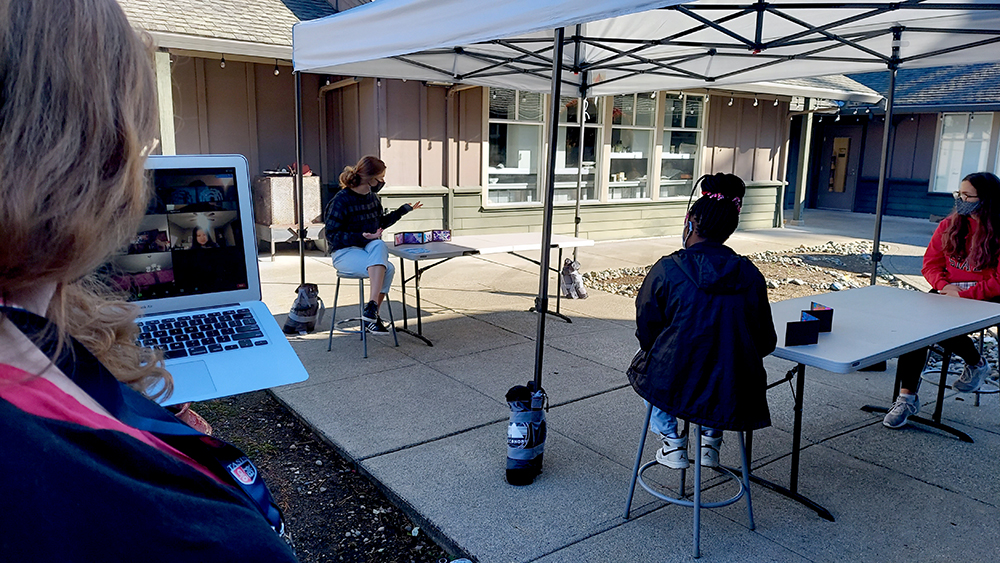Nurture in Nature
New Tarrier Outposts allow for intentional use of outdoor space for inquiry and place-based learning
by Kimberly Banti
Rain or shine, the Charles Wright campus often calls to mind the whimsical line from the children’s classic Winnie the Pooh: Deep in its hundred-acre wood, learners of all ages have long lingered in dappled shade and lush greenery, soaking up literature or collecting soil samples and everything in between.
When planning for a responsible reopening for fall 2020 amid the ongoing COVID-19 pandemic, CWA administrators, faculty, and staff saw the 107-acre campus as an invaluable resource for keeping students, employees, and families safe. Thus, Tarrier Outposts were born. With a master plan of creating 20 outdoor classroom sites this academic year, the school has intentionally invested in the development of optimally socially distant, covered, optically and acoustically separated, Wi-Fi–enabled Tarrier Outposts in which students and teachers can safely immerse themselves in lessons. Twelve such Outposts are currently operational, with plans to open the remaining eight as the rainy season sets in.
Tarrier Outposts not only provide an additional layer of health and safety precautions—on top of masking, sanitizing, and physical distancing—but also serve to deepen the school’s commitment to place-based education. “These outdoor classrooms lean into a part of what’s core to the Charles Wright experience: place-based learning expeditions, where the land and the locale become our textbook,” said Innovation and Design Labs Director Joe Romano.
“We have a rich history of making the Washington coast; Mount Rainier; Washington, D.C.; the Everglades; even Mount Everest a classroom for our students to explore and to learn in, and our campus offers a rich ecosystem for our students to dive into as well.”





The added benefit has been the creative tweaking of lesson plans and curriculum to both embrace the outdoor component of on-campus learning as well as to complement the study of remote Tarriers who continue their coursework off campus. “Hybrid teaching is incredibly challenging. What works for online learning doesn’t always work for in-person learning, and vice versa,” Mr. Romano said. “However, place-based learning offers some rich opportunities to connect remote and in-person learners.” For instance, sixth grade scientists recently programmed microcomputers to measure soil moisture levels. The varying locations allowed for richer inquiry, as both on-campus and remote learners were able to dive into comparative data. The same approach has been applied in the Upper School to field sketching in art classes and scrutinizing samples under smartphone microscopes in biology. “Whether you’re learning from home or learning on campus, you can create that sketch, you can collect that sample, and the entire learning community can wonder together about the differences in place,” Mr. Romano continued. “Plus, the learning here is active, and it’s joyful: We’re outside; we’re considering our place in our local ecology and community; and we’re discovering even more about the places we share.”
While CWA faculty are well-versed and highly experienced in teaching out of the traditional classroom thanks to the school’s long tradition of outdoor education, many have partaken in additional professional development specifically geared toward the type of place-based learning that the Tarrier Outposts provide. Last year, Lower School teachers began partnering with educators at Teton Science Schools, a nonprofit educational organization headquartered in Jackson Hole, Wyoming. Between pre-COVID in-person visits and regular virtual check-ins, teachers have been able to share ideas and apply new approaches to learning outside on campus. “We’re taking what we learned through our professional development with Teton Science Schools with inquiry-based and place-based learning and integrating our approach into a scope and sequence within the Lower School curriculum,” said first grade teacher Stephani Crozier, who led a farm-to-table unit alongside coteacher Jenn Kolbo.
“What we’re doing in first grade will lend itself into second grade environmental work on recycling and composting, third grade exploration of the watershed, and so on. Our farm-to-table inquiry spans science lessons, nonfiction reading, journal writing, and a service project. All of the different components can tie into other parts of our curriculum as well as other parts of our community.”
And because they reinforce such a foundational component of a CWA education, Tarrier Outposts will be part of campus long after the pandemic subsides. “Charles Wright has such a strong tradition of guiding our students out of the classroom and into the world, where the learning is a bit messier and where we nurture and challenge learners to become innovators, explorers, and stewards within a local and global community,” Mr. Romano said. “Our Tarrier Outposts are just one small mark in that tradition, and the equipment we’ve added to our collection, from large tents to camp chairs and portable whiteboards—all this will help strengthen this tradition in future years, as will be the learning experiences faculty members are designing this year.”

